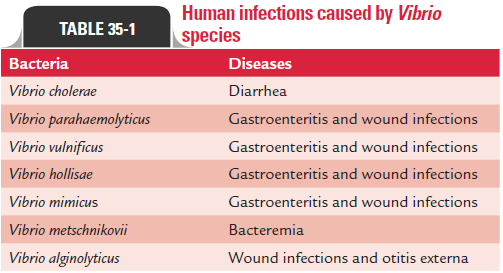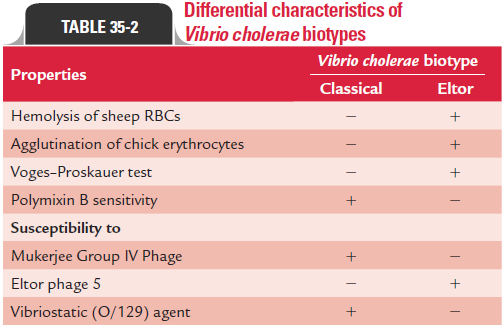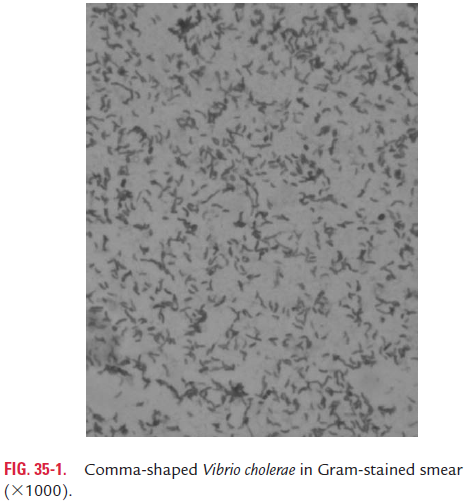Chapter: Microbiology and Immunology: Bacteriology: Vibrio,Aeromonas,and Plesiomonas
Vibrio cholerae: Properties of the Bacteria
Vibrio cholerae
V. cholerae is the most important species that causes cholera, themost feared epidemic diarrheal disease. Dehydration and death can occur rapidly within a matter of hours of infection.
Properties of the Bacteria
◗ Morphology
V. cholerae shows following features:
· cholerae are Gram-negative bacilli with rounded or slightlypointed ends. They measure 1–3 m in length and 0.5–0.8 m in diameter.
· The bacteria are typically comma shaped (Fig. 35-1). S-shaped or spiral forms may be seen due to two or more cells lying end to end.

· They are frequently pleomorphic in old cultures. In a stained film of mucous flakes from a case of cholera, the vibrios are typically arranged in parallel rows, described by Koch as the “fish in stream” appearance
· They are actively motile by the presence of a single polar fla-gellum. They show typical darting type motility and appear as a “swarm of gnats” when examined under the microscope.
· It is nonsporing, noncapsulated, and nonacid fast.
◗ Culture
V. cholerae is strongly aerobic and grows best under aerobic con-ditions, whereas growth is scanty and slow under anaerobic conditions. It grows within a temperature range of 16–40°C (optimum 37°C).
It grows better in an alkaline medium, the range of pH being 7.4–9.6 (optimum 8.2). Sodium chloride (0.5–1%) is required for optimal growth, though high concentrations (5% and above) are inhibitory for growth of the bacteria. Unlike other halophilic bacteria,V. cholerae can grow in the absence of salt.
V. cholerae grows well on a wide variety of media includingnonselective media (e.g., nutrient agar, MacConkey agar, blood agar, gelatin agar, and peptone water) and special media (trans-port media, enrichment media, and selective media).
1. Nonselective media:On nutrient agar,V. choleraeafter over-night incubation produces moist, translucent colonies with a bluish or greenish tinge. The colonies measure about 1–2 mm in diameter. The colonies emit a distinctive odor. The colonies on MacConkey agar are initially colorless after overnight incu-bation, but become reddish on prolonged incubation due to the late fermentation of lactose. On blood agar, V. cholerae biotype Eltor produces hemolytic colonies. Biotype Classical strains, however, produce greenish discoloration around the colonies, which later becomes clear due to hemodigestion. In gelatin stabculture,V. choleraeproduces infundibuliform (funnel-shaped) ornapiform (turnip-shaped) liquefaction after 3 days of incubation at 22°C. In peptone water, growth of bacteria forms a fine sur-face pellicle in about 6–9 hours of incubation.
2. Transport media: Transport media are used to transportstool samples in case of delay in processing the specimens in laboratory. These help in maintaining viability of V. cholerae and prevent the bacteria from being inhibited by normal intes-tinal bacterial flora present in stool specimens. Venkatraman– Ramakrishnan (VR) medium and Cary–Blair medium are two frequently used transport media.
· VR medium: This is a simple liquid medium prepared by dis-solving 20 g crude sea salt and 5 g peptone in 1L of distilled water. It is an alkaline medium with a pH of 8.6–8.8. The medium is dispensed in screw-capped bottles in volumes of 10–15 mL amounts. About 1–3 mL stool is to be added to each bottle.
· Cary–Blair medium: This is a solid medium. It consists ofbuffered solution of sodium chloride, sodium thioglycollate, disodium hydrogen phosphate, calcium chloride, and agar with an alkaline pH of 8. It is a suitable transport medium for Vibrio spp. as well as for Salmonella and Shigella spp.
3. Enrichment media: The enrichment media forV. choleraeare liquid media with a high pH. The high pH of the media suppresses growth of many commensal intestinal bacteria but favors the growth of V. cholerae. Alkaline peptone water (APW) and Monsur’s taurocholate tellurite peptone water are two examples of transport media used for V. cholerae.
APW: It is a frequently used medium for enrichment of stoolspecimens from patients convalescing from cholera, excret-ing few bacteria in their stool. The pH of APW is 8.6. Nearly 1 g of stool or rectal swab is inoculated into 10 mL of APW in a screw-capped tube and is transported to the laboratory. The APW is incubated at 37°C for 3–6 hours, and afterwards the subculture is made on the selective media.
Monsur’s taurocholate tellurite peptone water: Potassiumtellurite solution is added to the medium to make it more selective forV. cholerae. pH of the medium is 9.0. Stool or rectal swab is inoculated into the medium and incubated at 37°C for 3–6 hours, and afterwards the subculture is made on the selective media.
4. Selective media: These media are useful for isolation ofV. cholerae and other vibrios from feces. These include (a)thiosulfate citrate bile salt sucrose (TCBS) medium, (b) Monsur’s gelatin taurocholate trypticase tellurite agar (GTTA) medium, and (c) alkaline bile salt agar (BSA). All these media charcteristically have a high pH, which sup-presses growth of other intestinal bacteria but favors growth of vibrios.
TCBS medium (pH 8.6):This medium contains thiosulfate,citrate, bile salts, sucrose, and bromothymol blue (indica-tor). V. cholerae produces large, yellow convex colonies on this medium (Color Photo 35). This is due to fermenta-tion of sucrose by the bacteria, leading to production of acid. Accumulation of acid reduces pH of the medium, and so the color of the bromothymol blue indicator becomes yellow, thus making V. cholerae colonies yellow. Nonsu-crose-fermenting V. parahaemolyticus produces blue green colonies.
Monsur’s GTTA medium (pH 8.5):High pH of the mediumand presence of potassium tellurite in this medium inhib-its most of Gram-positive bacteria and enteric bacteria with exception of Proteus species. Hence, the GTTA medium is used for isolation of V. cholerae and other vibrios from feces.
V. cholerae produces small, translucent colonies with gray-ish black center and a turbid halo after 24 hours of incu-bation. The colonies become larger (3–4 mm in size) after a prolonged incubation of 48 hours.
Alkaline BSA (pH 8.2):This is another selective mediumused for V. cholerae. The colonies on BSA are similar to those on nutrient agar.
◗ Biochemical reactions
V. cholerae shows following features:
· It is catalase positive and oxidase positive.
· cholerae ferments sugars with production of acid only (nogas). It ferments glucose, sucrose, maltose, mannitol, and mannose. It is a late lactose fermenter ferments lactose on incubation for several days.
· It does not ferment arabinose, inositol, and dulcitol.
· It forms indole and reduces nitrates to nitrites.
V. cholerae shows positive cholera red reaction by producinga reddish pink color in the peptone water due to formation of nitroso indole. The two properties of formation of indole and reduction of nitrates to nitrites form the basis of cholera red reaction. This reaction is tested by adding a few drops of concentrated sulfuric acid to a 24-hour peptone water cul-ture at 37°C.
It is methyl red positive and urease test negative.
It liquefies gelatin and decarboxylates lysine and ornithine, but not arginine.
V. cholerae biotypes Classical and Eltor show variable Voges–Proskauer reaction, hemolysis of sheep RBCs, and hem-agglutination of chick RBCs. The differences between Classical and Eltor biotypes of V. cholerae are summarized in Table 35-2.

◗ Other properties
Susceptibility to physical and chemical agents: V. choleraeis most susceptible to heat, drying, acids, and common disin-fectants. V. cholerae are killed by heating at 56°C for 30 min-utes, killed in a few minutes in gastric juice of normal acidity. They are resistant to high alkalinity. They remain viable for 1–2 weeks in fresh sea water. They survive in pure tap water for up to 30 days. On fruits, they survive for 1–5 days at room temperature and for a week in the refrigerator. However, vibrios do not survive longer in grossly contaminated water, such as river Ganga water in India—most possible due to the presence of large number of bacteriophages in this water. They survive for several days in untreated excreta of humans.

Related Topics